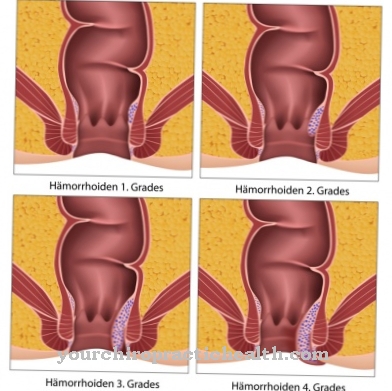The Foot and mouth disease is a notifiable disease that is transmitted by viruses and mainly affects ungulates.
What is foot and mouth disease?
.jpg)
© borevina - stock.adobe.com
The Foot and mouth disease primarily affects pigs and cattle. Theoretically, however, most of the other ungulates are also possible carriers of the viral disease. The highly contagious disease also affects goats, sheep, red deer and fallow deer.
Other possible carriers are elephants, hedgehogs, mice, rats and humans. Skin and mucous membrane lesions are symptomatic of foot and mouth disease. The incubation period is 2 to 18 days, depending on the species. Although humans can also be infected by foot and mouth disease, the disease is considered an animal disease.
causes
The Foot and mouth disease is a viral disease and breaks out when the foot-and-mouth disease virus infects the host. The foot and mouth disease virus is a picornavirus and is therefore one of the smallest viruses.
The pathogen is transmitted through smear or contact infection. A droplet infection is also conceivable. If a living being is infected, small vesicles that are filled with fluid appear, especially in the mouth or mouth area. These vesicles, which are also known as canker sores, contain the pathogen that spreads from there.
Routes of infection can be animal products, clothing or work equipment. The pathogen can also spread through the air. In the majority of cases, the pathogen is absorbed through the mouth area, i.e. oral infection ensues.
Symptoms, ailments & signs
The name foot-and-mouth disease already indicates on which parts of the body the typical symptoms appear. Initially, however, classic flu symptoms appear with the disease. Fever, headache, sore throat and body aches, poor performance and loss of appetite are possible. A few days after these symptoms appear, characteristic pustules develop in the mouth.
These red spots are mainly found on the tongue, gums, and lining of the mouth, or near the lips. They develop relatively quickly into small blisters or ulcers that are painful to the touch and fill with pus or tissue fluid as the disease progresses. As a result, a rash also develops on the hands and feet. This also consists of red spots of different sizes, shapes and numbers.
At first, the rash does not itch, but itching and pain develop over time. Blisters form on the reddened areas, which secrete a secretion. The palms of the hands and the soles of the feet are usually affected. The red pustules can also appear in the buttocks, in the genital area and in the knee and elbow area. If the sick person maintains thorough hygiene, the symptoms subside after a few days.
Diagnosis & course
The Foot and mouth disease causes only mild symptoms in an infected person, which are insufficient to allow an accurate diagnosis to be made. In order to diagnose the disease, it is therefore necessary to inform the doctor about previous contact with animals. A blood test will also be done to detect antibodies. Analysis of the fluid in the vesicles that have formed can also provide information about whether there is an infection.
In contrast to humans, animals that are infected with foot and mouth disease have very clear characteristics. In addition to the typical blisters, the disease is noticeable through an unusually strong salivation and high fever. If an animal is infected, the disease spreads from the mouth area through the esophagus to the stomach.
The resulting pain leads to the affected animals completely refusing to eat after just a few days. At the first signs of foot-and-mouth disease in an animal, the responsible veterinarian must be reported immediately. In humans, however, the disease is not reportable and is harmless.
Complications
As a rule, foot-and-mouth disease does not cause symptoms or any particular complications. As a rule, people do not react to this disease, so that it does not result in a health-threatening condition for the person affected. However, the body can produce antibodies against foot and mouth disease itself.
In some cases, those affected suffer from the common symptoms of a cold or a flu-like infection due to foot-and-mouth disease. This leads to a fever, aching limbs and severe headaches. In most cases, the symptoms themselves disappear relatively quickly and do not lead to complications or consequential damage. For this reason, no special treatment by a doctor is necessary and self-healing usually occurs.
Affected animals must, however, be kept separately so that the foot-and-mouth disease is no longer transmitted. The symptoms can be reduced and fought with the help of medication. Further treatment or further medication is not necessary. Foot and mouth disease does not lead to a reduction in life expectancy in humans.
When should you go to the doctor?
Since foot and mouth disease is a highly contagious disease, a doctor should be consulted at the first signs of the disease. The disease usually affects children among humans. Sudden changes in the appearance of the skin indicate an irregularity that must be clarified by a doctor. If the symptoms occur in older children or adults, a doctor should nevertheless be consulted immediately. If sore red spots form on the skin, this is cause for concern. The hands, feet and mouth regions are affected. If the symptoms spread within a few hours, a doctor must be consulted.
See a doctor for rash and discoloration of the skin that is accompanied by itching. Symptoms should be clarified if you have a fever, sore throat, aching limbs or loss of appetite. If there is a decrease in normal performance, a social withdrawal or a loss of well-being, a doctor should be consulted. If children lose the fun of playing or if they show other behavioral problems, the observations should be discussed with a doctor. Increased perspiration under the soles of the feet or in the palms of the hands are further indications of an existing irregularity that should be examined by a doctor.
Treatment & Therapy
Treatment of the Foot and mouth disease is not possible with a sick animal. To date, there is no therapy that renders the causative FMD virus harmless. Since foot and mouth disease primarily affects animals that are kept in large numbers as farm animals, it is essential to kill the animals when the disease is first suspected in order to prevent the disease from spreading.
Foot and mouth disease, however, is not always fatal. Adult animals in particular can survive the disease if they are kept in isolation from other infected animals. If a person suffers from foot and mouth disease, treatment is often not necessary. The symptoms are very weak and subside after a short time. In exceptional cases, symptoms such as headache and body aches or a slight fever occur. In these cases, conventional drugs are used to relieve the symptoms. However, the majority of infections in humans are completely symptomatic.
Outlook & forecast
When making a prognosis, a distinction must be made between who it refers to. There are very good healing prospects for humans. These exist even if he does not see a doctor at all. Complaints do not occur at all or are perceived as marginal. The disease is completely healed after about two weeks.
Opposite prospects arise for the sick animals. Since foot-and-mouth disease has not yet been curable, all animals must be killed. According to the legal requirements, there is also an obligation to kill cattle that have been in contact with the infected animals. The company then becomes a restricted zone. The carcasses must be destroyed separately. This is to prevent spreading through transmission.
Scientific studies have shown that young animals in particular die of foot and mouth disease. With them it is about 70 percent, while the adult cattle survive 95 percent. In view of the prescribed extermination of all possible risk animals, however, these prospects are irrelevant. In addition, the necessary isolation of the animals cannot be implemented in practice. Factory farming does not produce sufficient capacities.
prevention
The Foot and mouth disease breaks out in animal populations and there may be spread to humans. When the disease occurs, measures must therefore be taken promptly to prevent the spread of the disease. Affected animal farms are surrounded by a restricted zone, sick animals must be euthanized. Objects and people who have come into contact with sick animals must be thoroughly disinfected. This is done using acidic disinfectants that kill the acid-sensitive FMD virus.
Aftercare
If the foot and mouth disease could be cured with the attending physician, there is no need for follow-up care. However, those affected should avoid areas of infection in the future and generally adopt a healthy lifestyle. The weakened immune system will need a while after the acute treatment to regain its usual stability. A positive attitude can aid the recovery process. It can happen that a general tiredness and fatigue persists, which is why patients cannot fully participate in everyday life. They are therefore often dependent on the help of relatives and friends. If you experience unusual symptoms that make you feel more unwell, consult a doctor immediately.
You can do that yourself
With foot-and-mouth disease, the person concerned rarely needs special help because the disease in humans is very seldom severe. However, every patient should know and take into account for the benefit of third parties that foot and mouth disease is a zoonosis that can be transmitted from animals to humans and vice versa. The disease is very troublesome and very painful for animals and is often fatal.
An outbreak of the disease in humans, unlike in animals, does not have to be reported. Infected people should nevertheless consult a doctor and also keep in mind that the disease, which they can transmit to cloven-hoofed animals, can have devastating economic consequences and destroy entire animal populations. Cattle, pigs, sheep, goats as well as red and fallow deer are particularly affected. Horses and donkeys do not develop FMD. However, wild animals such as rats and hedgehogs can become infected.
If FMD is suspected, an affected person should definitely inform all animal owners with whom he has recently been in contact. Anyone who owns endangered animals should inform the veterinarian immediately and keep away from all animal species at risk of infection. These must not be fed, milked or petted in order to prevent infection. Also, pet shops and zoological gardens should not be visited, as exotic animals can also become infected.


.jpg)
.jpg)
.jpg)
.jpg)








.jpg)













